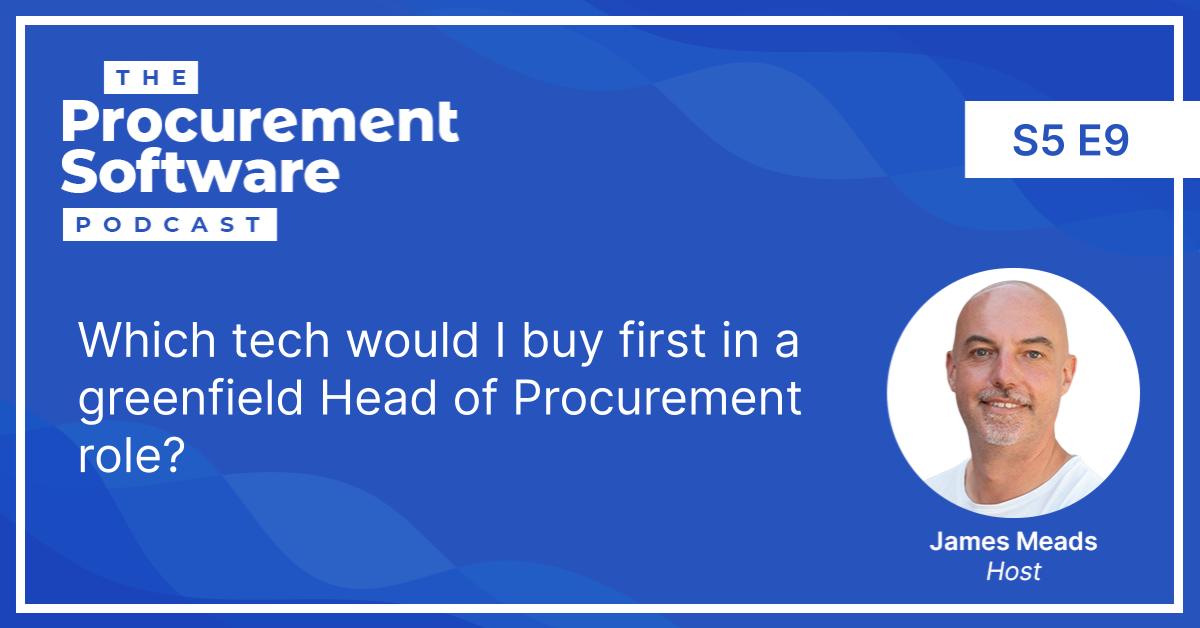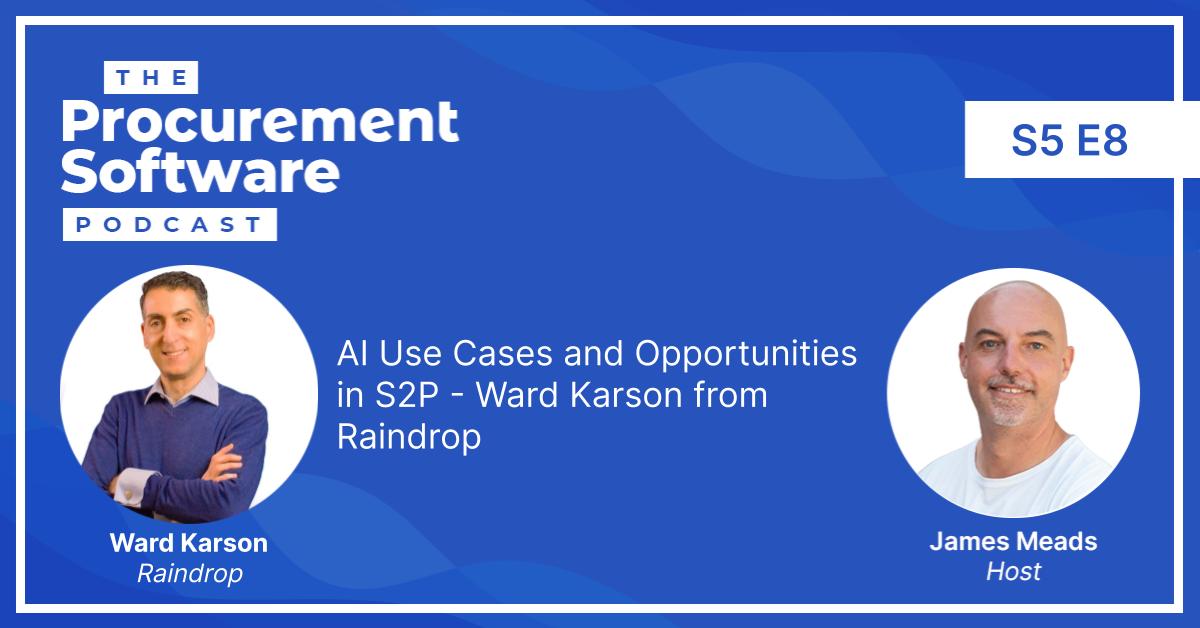Welcome to another episode of The Procuretech Podcast!
We’re continuing our third series of conversations with industry leaders, which now releases twice a week.
Procurement Media through the Years – Jon Hansen from Procurement Insights
This episode, we’ve got a guest who’s been talking about procurement for decades. With a long-standing blog and a podcast that goes all the way back to 2009, it’s Jon Hansen of Procurement Insights – the original procurement podcaster.
We’re going to talk about everything that’s changed in the world of procurement over the course of Jon’s long-standing career.
Jon’s career as a long-standing procurement commentator
Jon’s been in the tech industry for more than 40 years, and procurement for almost as long. This has given him experience both as a practitioner and provider.
One of his first business ventures was to start a company with funding from the government. It leveraged algorithms that allowed the Department of National Defence to procure indirect materials for their entire nationwide military installation base. He later moved to doing the same thing for the New York City Transit Authority.
Jon sold that company in 2000, and that’s when he began to shift towards blogging.
He’d already had a lot of media experience from interviews in his role as a company founder. When someone in the media world said “why don’t you start a blog?”, his first thought was “what’s a blog?”.
This was around 2007. By 2009, Block Talk Radio was launched in New York City. With guests from the world of business and procurement, it broadcast a deeper understanding of procurement to an entirely new audience, through an entirely new medium.
Jon jokes that he’s always had a face for radio, but he clearly had the talent to match: Some 900 episodes later, the monthly listener base was up to 15,000 a month.
And that eventually dovetailed into where Jon is today with Procurement Insights.
Was digital transformation a hot topic back then compared to what it is today?
While it wasn’t called transformation back then, it’s interesting that a lot of the same issues were still being talked about 20 or 30 years ago.
One of the biggest challenges in the procurement world was that the earlier platforms were ERP based. Procurement personnel and professionals weren’t involved in the selection process of that technology. That was a Finance decision.
So there was a great deal of frustration with the majority of ERP implementations. Not that ERP doesn’t have a vital role to play. But back then the majority of e-procurement initiatives would fail miserably, costing 10s of millions of dollars.
The emergence of the on demand or SaaS software was exciting. Because that started a shift away from a centralised, monolithic approach to automation, to one that was strategically effective and geared towards the procurement people.
The interesting point, as we track this story over the last 10 or 20 years, is the value of human experience. In 2019, a Deloitte CPOE global survey indicated that the majority of CEOs were dissatisfied with the results of their initiative.
Of course, their ERP technology was cumbersome. But ultimately it was the mindset and approach that was at fault. It was how to leverage that technology and implement it.
That inspired the move from Procurement being a function of Finance, to being a key strategic player within the enterprise.
And now we’ve learned that from the pandemic more so than ever before. It’s caused organisations and people to look at the technology through a much different lens.
In other words, you don’t throw technology at something and expect it to fix everything. You have to have the right people in place. You have to decide on the right technology and understand how to utilise it effectively. You have to adapt the technology to your processes.
Technology doesn’t improve process. Process has to be improved using technology as a tool.
As an example, there was a major service organisation, which gave their tax incentives by the number of service calls they could do in a day. The more service calls you did, the better your score, and the better your compensation.
On the other side, though, they wanted to implement a system whereby on-site technicians could go online to order necessary parts on location. One of the biggest problems, however, is that the technology was cumbersome. It didn’t save time, because they couldn’t make as many calls if they had to stop at each location to wrestle with cumbersome technology.
So what ended up happening was what’s known as sandbagging – where we’re there to hold the technology, or hold all the orders until the end of the day.
The problem there is that with indirect materials, especially computer technology, the price in the morning of a particular part may be $100. But by late afternoon, as the geographic time zone of sourcing began to shrink, that price could easily become $800, $900 or $1,000.
The technicians were really doing their job based upon the incentives that were created for them, but in the long run, it drove up the cost of the parts that they needed.
So they had to look at the technology and say wait a second, how are we going to be able to make it easier for technicians to leverage the technology?
And that’s why we now see these intuitive, Amazon-like user experiences. That was always the goal – it was just very difficult to get there in the early days.
How do you complement the performance or the requirements of the service technician with the objectives of hitting an SLA but doing it on a cost efficient basis where you were not paying a lot to get these products?
It’s a combination of processes, AND you’ve got to bring those together and collaborate more effectively.
In many organisations this was tough, because procurement was rarely involved with anything strategic, rarely seen as doing more than simply buying at the lowest cost when needed. And so the biggest change is that the procurement and professionals in supply chain are now seen as the leader, rather than a spectator in digital transformation.
Freeing up procurement professionals, and the future of procurement
There’s a lot of talk about fully automated P2P ‘freeing up procurement professionals’ to focus on more value added stuff. But what does this mean for the future of procurement?
The trouble is, when you create all of this freedom to let people become more strategic in their tasks, what exactly does that mean?
For example, with the Department of Defence, they had 21 buyers, 21 people managing contract infrastructure, and it was a large contract. Through the automation process,within 18 months, they went from 21 buyers down to three.
So here’s the question – what do you do with the other 18?
It depends on how willing and how capable they are to upskill and adapt. If a procurement professional is willing to move with the times and see the writing on the wall, that headcount and within procurement teams won’t necessarily be fewer than today. The roles are just going to look very, very different.
There’s a major overhaul happening within the procurement realm.
When we become less functionally driven and more strategically driven, we have to expand to new areas of endeavour.
We have to look at data management, and what we do with that data. Digital transformation is impossible without clean data.
And the fact remains that the majority of organisations (according to IDC) only analyse 5% of the data they have. They’re flying blind, even with the automation. So who’s going to take the lead on that?
We have to look at factors such as cybersecurity, too. A study in Supply Chain Digest found that 53% of all enterprise breaches occurred through a third party partner or vendor.
Who should own those third party vendor relationships? Should it be finance? Should it be procurement? There’s a new role there.
And there’s not really anyone better positioned than procurement professionals to understand how to structure those relationships, how to engage suppliers, how to coordinate that and manage those risks.
That extends even into non cyber threat areas: Managing ESG objectives and goals, for example.
You’ve got to choose the right suppliers, you’ve got to build the right infrastructure. So we have become strategic and view our role beyond the traditional limitations of getting something at the best price as fast as we can.
The value of internal marketing
As aspects of traditional procurement are automated and phased out, we’ll have to spend more time communicating. With suppliers, but also within our own organisations.
Procurement as a function, historically, has been dreadful at internal marketing and communication. Compared to sales or environmental health and safety, when it comes to communicating their message, procurement has a long way to go.
If you do a survey on LinkedIn, and say: “Procurement pros, do you think it’s harder to negotiate with external suppliers or to convince stakeholders to implement your initiatives?” 9 times out of 10, they’ll always say negotiating internally is harder.
We have to do a better job of selling our own identity. And thus that positions us to take the lead in these new strategic arenas – like cybersecurity, like data management, like all of these other aspects of it. We can no longer be spectators. We’ve got to be able to make sure that people are coming into the profession for the right reason with the right understanding. It begins with us.
Jon shares the story of a procurement professional who once approached him at a conference. He said he was ready to go to his company the next morning all motivated, full of new ideas, and they’re going to say: “No. That’s not your role”.
That professional asked Jon what he should do, and Jon said – you find another company. That may seem like a smart remark, but there’s truth to it. Companies have to embrace change.
Technology doesn’t repair the challenges that we’re running into now, because the challenges reside in how organisations define and recognize the importance of procurement.
And that not only starts at where we are as professionals, but also starts at the top of the organisation in the highest levels. Companies need to provide the right incentives, guidance and motivation to expand the scope of procurement.
Organisations that do that will ultimately be more successful than those that continue to operate within the confines of what we were in the past.
Wrapping Up
Jon is such a fountain of knowledge that we really could have spoken all day, but sadly that’s all we have time for.
If you want to reach out to Jon, or to us here at The Procuretech Podcast, you’ll find all the links you need below.
Thanks for listening, and we’ll catch you in a few days for the next episode.
Stay in touch
- Check out Jon’s Procurement Insights Podcast
- Connect with Jon on LinkedIn
- Sign up for the Procurement Software Newsletter
- Book an Intro Call and let’s talk all things Digital Procurement!
- Connect with James on LinkedIn
- Follow Procurement Software’s LinkedIn Page


